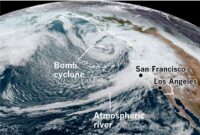Human exploration of the cosmos soared to new heights in 2022, a year that saw a bounty of first-ever missions and discoveries for scientists probing and studying the stars. The James Webb Telescope went deeper into the universe’s past than ever before, NASA initiated its first return to the lunar surface since the Apollo missions and a team of scientists successfully shot a Here’s a look back at the most notable moments for space exploration this year.
Mystery rocket crashes into the Moon and no one knows where it came from
One of 2022’s greatest space mysteries was NASA’s discovery of a massive double crater on the far side of the Moon, the crash site of an unknown rocket body. On June 24, NASA’s Lunar Reconnaissance Orbiter shared images of the unusual impact. Months later, none of Earth’s space-exploring nations has claimed responsibility for the rocket, which astronomers spotted on a collision course with the Moon in late 2021. Astronomer Bill Gray initially believed it be a SpaceX part but later concluded it was likely part of a 2014 Chinese test mission, called Chang’e 5-T1. However, Chinese officials denied it came from a Chinese rocket.
James Webb Telescope pulls back the curtain on the unseen universe
After launching the James Webb Space Telescope (JWST) at the tail-end of 2021, NASA finally unveiled a highly anticipated series of some of the first galactic images captured by the powerful telescope on July 12. The gold-plated JWST, the largest optical telescope in space, easily put the capabilities of its predecessor the Hubble Space Telescope to shame, uncovering details about never-before-seen exoplanets, the earliest stars in the universe, and the farthest galaxies ever known to man. A team of musicians and scientists later translated visual data some of the most iconic images from the telescope into soothing music through a process known as sonification.
Astronomers capture the eerie sound of a black hole
Back in August, NASA took to Twitter to share an audio clip capturing the eerie sounds emitted from a supermassive black hole at the center of the galaxy cluster Perseus over 250 million light years away from Earth, unsettling some social media users in the process. The sound waves, extracted from the center of the black hole, were made audible for humans for the first time after being released in May.
Humans snipe a distant asteroid for the first time eve
After launching from Earth in 2021, NASA’s Double Asteroid Redirection Test (DART) spacecraft finally arrived at Dimorphos, a small planet moon of the asteroid Didymos, crashing at high speed into the moon’s gray, pockmarked surface. DART’s crash-landing on Sept. 26 successfully altered the orbit of the space rock, shortening the asteroid’s orbital period by a whopping 32 minutes. The collision was the intended result of a mission years in the making and the goal of testing if mankind could shift the trajectory of traveling space debris in the name of planetary defense. The carefully planned crash landing also left Dimorphos resembling a comet with 6,000 miles of debris trailing in its wake in the days after the test.
Space Center Houston reveals major expansion plans
Upon the 30th anniversary of its opening on Oct. 16, Space Center Houston announced plans for a major expansion of its facility to help meet growing demands for space exploration learning and training as humans look to return to the Moon and eventually land on Mars. The cornerstone of the project will be the construction of a 100-acre Lunar Mars Immersive Experience and Learning Center that will simulate the cosmic terrains of the Moon and Mars. The Space Center also aims to bring space and people closer together by allowing enthusiasts to view astronaut training happening at a new lab at the facility.
What could be the most powerful explosion ever was discovered
Scientists recorded a cosmic explosion on Oct. 14 that could likely be the most powerful ever recorded. Dubbed the “BOAT,” or brightest of all time, GRB 221009A was detected on Oct. 9 following a record-breaking gamma-ray burst likely triggering a massive supernova explosion that gave birth to a black hole approximately 2.4 billion light-years away from Earth in the direction of the constellation Sagitta. At the time, scientists said the uniquely bright and energetic gamma-ray burst can will help them to learn more about elements formed and ejected during a massive star collapse.
Astronaut team forms to study UFOs
NASA announced at the end of October the formation of a 16-person team of scientists that will study unidentified aerial phenomena (UAPs), formerly known as UFOS, for nine months in the interest of national security and air safety. The team, comprised of NASA veterans, former astronauts, physicists and others will research how data gathered by “civilian” government entities, commercial data, and data from other sources can be used to investigate “events in the sky that cannot be identified as aircraft or known natural phenomena,” with a special focus on unclassified data.
NASA launches historic Artemis 1 mission to the Moon
On Nov. 16, NASA’s Orion spacecraft launched atop the space agency’s most powerful rocket yet, the NASA Space Launch System (SLS), marking the first in a series of Moon missions that will ultimately see the first human landing on the Moon since Apollo 17 in 1972, and build a base on our nearest space neighbor, with the help of Austin-based robotics company ICON, to establish a long-term human presence on the lunar surface. NASA hopes to use lessons learned from the missions to aid in sending the first astronauts to Mars. The historic mission went smoothly, with the Orion capsule traveling the farthest distance from Earth by any spacecraft built for humans. The space vehicle splashed down in the Pacific Ocean off the west coast of Baja California on Dec. 11 after traveling more than 1.4 million miles around the Moon and back.
Top secret space plane finishes longest mission yet
Just three days before the Artemis launch on Nov. 13, the U.S. Space Force’s unmanned Boeing X-37B Orbital Test Vehicle (OTV), touched down at NASA’s Kennedy Space Center after spending 908 days orbiting Earth. On a classified mission known only as OTV-6, the X-37B launched in May 2020 outfitted with ring-like service module attached to its rear in order to expand the number of experiments it could host while circling the Earth. can be hosted during missions. Among the vehicle’s known testing operations was a partnership with the Naval Research Laboratory involving the conversion of solar power into microwave energy, according to Boeing executives.
SpaceX moves to launch first-ever private Moon rover
Much like the Artemis 1 mission, SpaceX’s attempted launch of a Japanese moon lander faced some delays before it finally lifted off atop a SpaceX Falcon 9 rocket on Dec. 11. If successful, the Hakuto-R lander built by Tokyo-based company ispace will become the first privately-led Japanese mission to land on the Moon, with a soft lunar touchdown slated for next spring. Included among both private and public payloads aboard the moon lander is the NASA Jet Propulsion Laboratory’s Lunar Flashlight, a briefcase-sized satellite that will hunt for water ice on the Moon and serve as an important resource for future Artemis missions to the lunar surface.




GIPHY App Key not set. Please check settings